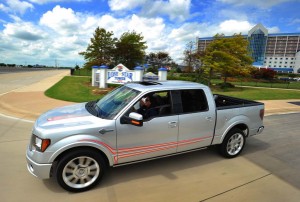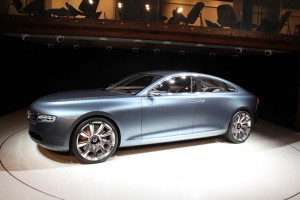Nearly six of every 10 Ford F-Series pickups now are being purchased with V-6 powertrains, Ford officials confirm, a significant shift away from the classic V-8s that have long been the engines of choice among full-size truck buyers.
The downsizing reflects a variety of factors, according to top Ford officials, including a growing emphasis on fuel economy among all U.S. buyers. But Ford is also benefitting from the development of a new generation of high-performance V-6s that can match and, in some cases, even exceed the performance and towing power of bigger eights, even while delivering significantly better mileage.
The shift seen by Ford isn’t limited to big trucks. Across the board, American motorists are migrating to smaller powertrains – and several makers are responding by planning big changes in their engine line-ups. Hyundai has largely switched to I-4s for its mainstream line-up, and Volvo soon plans to shift to 4- and even 3-cylinder engines across the board.
“People are looking at fuel economy more than ever,” says Ford’s President of the Americas Mark Fields, who adds that the key selling point is that with the new engines, “you don’t have to compromise.”
The shift at Ford began with the launch of the 2011 F-Series, Ford introducing both a conventional V-6 and a V-6 version of its increasingly popular EcoBoost engine line-up. Together, they accounted for a full 57% of F-150 sales in August, the EcoBoost engine alone accounting for 41% of demand for the nation’s best-selling pickup.
The EcoBoost has become the high-profile star in the Ford line-up. It uses a number of technologies normally found on the most modern diesels, including high-pressure fuel injection and advanced turbochargers. With the engines used in the F-Series as well as Ford’s high-performance Taurus SHO that allows the maker to advertise it is delivering “the performance of a V-8 with the fuel-economy of a V-6.”
“Conventional wisdom would have said not to do this,” admitted Ford’s Fields. If anything, recent years had seen a push for even bigger and more powerful V-8s in vehicles like the F-Series, and competing models such as the Chevrolet Silverado, Chrysler’s Ram and Toyota’s Tundra.
But Ford has seen a general trend towards powertrain downsizing. In fact, industry analysts like Joe Phillippi, of AutoTrends Consulting, suggest that U.S. motorists seem much more comfortable with shrinking powertrains than smaller cars. While compact and subcompact vehicles have clearly gained share as fuel prices have soared to near-record levels, sales have not matched what some forecasters had anticipated.
The move to smaller engines can be seen in all segments of the marketplace. Even makers of high-performance luxury manufacturers like Mercedes-Benz are opting for smaller displacements and fewer cylinders. The good news for those who like horsepower and torque is that direct injection, superchargers and turbochargers can often make up the difference – and then some.
Some of the latest 4- and 6-cylinder engines are churning out as much as 100 to 125 horsepower per liter, significantly more than even the most high-performance V-8s of the past.
The good news is that a smaller engine is also a lighter one, and that, in turn, allows for additional weight savings in a vehicle, as Hyundai realized when it chose to go with a 4-cylinder-only strategy with the latest-generation midsize Sonata. With a smaller engine cradle, among other things, it meant that the weight of the basic platform was cut by more than 100 pounds compared to the previous model, noted Hyundai Motor America CEO John Krafcik.
Hyundai still has V-6s and -8s in its line-up. It added an even bigger 5.7-liter powerplant, in fact, for the newly-updated Genesis luxury sedan earlier this year. But among mainstream models, where the maker is pressing a 40 mpg marketing strategy, I-4s will likely remain the engine of choice.
Then there’s Volvo, the now Chinese-owned Swedish automaker’s CEO Stephan Jacoby announcing “We will downsize our powertrain range to only 4-cylinders” going forward. But he also promised that the new engine line-up will deliver not only about 35% mileage but also a fair bit more power than the V-6s Volvo offers today.
Actually, Jacoby’s comments at the Frankfurt Motor Show were somewhat inaccurate, he later corrected. The maker is also planning to introduce new 3-cylinder engines as part of the Volvo Environmental Architecture powertrain family. The first of the 1.5-liter I-3 and 2.0-liter I-4 engines will begin rolling out in 2013, with the new line-up expected to completely take over by 2020.
Sixes and eights won’t vanish entirely. The bigger engines will likely remain popular in muscle cars like the Ford Mustang, though even there the maker continues to see more and more buyers shift to the smaller six it offers – especially after upgrading that engine to 305 horsepower.
But Ford will continue downsizing elsewhere, the maker next set to introduce a 3-cylinder version of its EcoBoost for use in the subcompact Fiesta and other small cars.
Fiat, meanwhile, is selling a two-cylinder Twin Air engine in Europe that may soon make its way to the States.
Smaller engines delivering more power and better mileage appears to be a winning combination for U.S. motorists.



“Fiat, meanwhile, is selling is selling a two-cylinder Twin Air engine in Europe that may soon make its way to the States”
“Smaller engines delivering more power and better mileage appear to be the winning combination for U.S. motorists.”
The two-cylinder “TwinAir” engine of Fiat-500 was not only voted as, by far, the best-engine-of-the-year 2011 in Stuttgart Germany, but it succeeds to conquer the top of power and mileage while working according less, thermodynamically, efficient modes.
It takes a little and inexpensive modification of the camshaft and a reprogramming of the ECU to make it work not only according the present modes / strategies of Fiat MultiAir / TwinAir (late intake opening, early intake closing, multilift, full lift, deactivation) but also according the Toyota’s Prius modes (Atkinson –Miller cycle, over-expansion) and thereby to become more green and more powerful with better mileage, as explained at http://www.pattakon.com/pattakonHydro.htm
The hydraulic system of Fiat TwinAir opens reliably the intake valves overcoming both, the inertia loads of the valve and the tension of the restoring valve spring.
The HyDesmo at http://www.pattakon.com/pattakonHyDesmo.htm uses the hydraulic system not only to open the valves positively, but also to close the valves positively without restoring valve springs.
The HyDesmo operates according all the modes / strategies of Fiat MultiAir / TwinAir.
Without restoring valve springs, the resistance of the valve to move (and the power consumed by the valve train) is smaller, the mass of the valve assembly is smaller, while the rev limit and the peak power increase.
Thanks
Manousos Pattakos